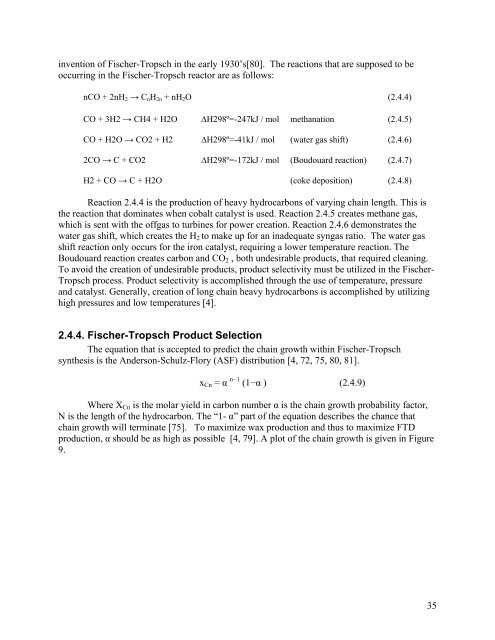Novel Design of an Integrated Pulp Mill Biorefinery for the ...
Novel Design of an Integrated Pulp Mill Biorefinery for the ...
Novel Design of an Integrated Pulp Mill Biorefinery for the ...
Create successful ePaper yourself
Turn your PDF publications into a flip-book with our unique Google optimized e-Paper software.
invention <strong>of</strong> Fischer-Tropsch in <strong>the</strong> early 1930’s[80]. The reactions that are supposed to be<br />
occurring in <strong>the</strong> Fischer-Tropsch reactor are as follows:<br />
nCO + 2nH2 → CnH2n + nH2O (2.4.4)<br />
CO + 3H2 → CH4 + H2O ∆H298º=-247kJ / mol<br />
CO + H2O → CO2 + H2 ∆H298º=-41kJ / mol<br />
2CO → C + CO2 ∆H298º=-172kJ / mol<br />
meth<strong>an</strong>ation<br />
(2.4.5)<br />
(water gas shift) (2.4.6)<br />
(Boudouard reaction) (2.4.7)<br />
H2 + CO → C + H2O (coke deposition) (2.4.8)<br />
Reaction 2.4.4 is <strong>the</strong> production <strong>of</strong> heavy hydrocarbons <strong>of</strong> varying chain length. This is<br />
<strong>the</strong> reaction that dominates when cobalt catalyst is used. Reaction 2.4.5 creates meth<strong>an</strong>e gas,<br />
which is sent with <strong>the</strong> <strong>of</strong>fgas to turbines <strong>for</strong> power creation. Reaction 2.4.6 demonstrates <strong>the</strong><br />
water gas shift, which creates <strong>the</strong> H2 to make up <strong>for</strong> <strong>an</strong> inadequate syngas ratio. The water gas<br />
shift reaction only occurs <strong>for</strong> <strong>the</strong> iron catalyst, requiring a lower temperature reaction. The<br />
Boudouard reaction creates carbon <strong>an</strong>d CO2 , both undesirable products, that required cle<strong>an</strong>ing.<br />
To avoid <strong>the</strong> creation <strong>of</strong> undesirable products, product selectivity must be utilized in <strong>the</strong> Fischer-<br />
Tropsch process. Product selectivity is accomplished through <strong>the</strong> use <strong>of</strong> temperature, pressure<br />
<strong>an</strong>d catalyst. Generally, creation <strong>of</strong> long chain heavy hydrocarbons is accomplished by utilizing<br />
high pressures <strong>an</strong>d low temperatures [4].<br />
2.4.4. Fischer-Tropsch Product Selection<br />
The equation that is accepted to predict <strong>the</strong> chain growth within Fischer-Tropsch<br />
syn<strong>the</strong>sis is <strong>the</strong> Anderson-Schulz-Flory (ASF) distribution [4, 72, 75, 80, 81].<br />
xCn = α n−1 (1−α ) (2.4.9)<br />
Where XCn is <strong>the</strong> molar yield in carbon number α is <strong>the</strong> chain growth probability factor,<br />
N is <strong>the</strong> length <strong>of</strong> <strong>the</strong> hydrocarbon. The “1- α” part <strong>of</strong> <strong>the</strong> equation describes <strong>the</strong> ch<strong>an</strong>ce that<br />
chain growth will terminate [75]. To maximize wax production <strong>an</strong>d thus to maximize FTD<br />
production, α should be as high as possible [4, 79]. A plot <strong>of</strong> <strong>the</strong> chain growth is given in Figure<br />
9.<br />
35

















